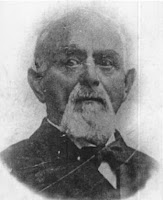History of Jeans
strauss and Davis combine denim and rivets
The history of blue jeans can be traced to two men - Levi Strauss (1829 - 1902), a German who emigrated to the United States as a young boy, and the lesser-known Latvian Jacob Davis (1834 - 1908), who moved to the United States in 1854.
In 1853 Levi Stauss moved to San Franciso where he set up a company, Levi Stauss & co., selling buttons, scissors, bolts of cloth, and canvas. He also designed heavy-duty canvas work overalls for local miners. When his canvas supplies ran out, he began using heavyweight cotton twill, later known as denim.
One of Strauss's customers was a tailor, Jacob Davis, who also made work trousers. His clients were complaining that the pockets kept ripping out, so Davis devised a method of strengthening the pocket corners
and fly fastenings with metal rivets. This was an immediate success, but Davis did not have the money to obtain the patent, so he approached Strauss. An astute businessman, Stauss paid for the paperwork and the two men filed a joint patent for the new rivet-strengthened work trousers on May 20, 1873.
Davis went to work for Levi Stauss & Co., overseeing the production of the new work trousers, which were not called jeans until the 1960s. They quickly became popular and their fame as the best work trousers spread and their fame as the best work trousers spread throughout the United States. In around 1890 the patent ran out, allowing any company to manufacture riveted jeans. At the same time, Levi Stauss & Co. assigned their jeans the number 501. The term Levi's, however, was not coined by the company but by the public, and the company trademarked the name.
- Jean-wearing miners pose by a wagon in the 1890s, a portrait tailor-made for the rugged Levi's image.





No comments:
Post a Comment